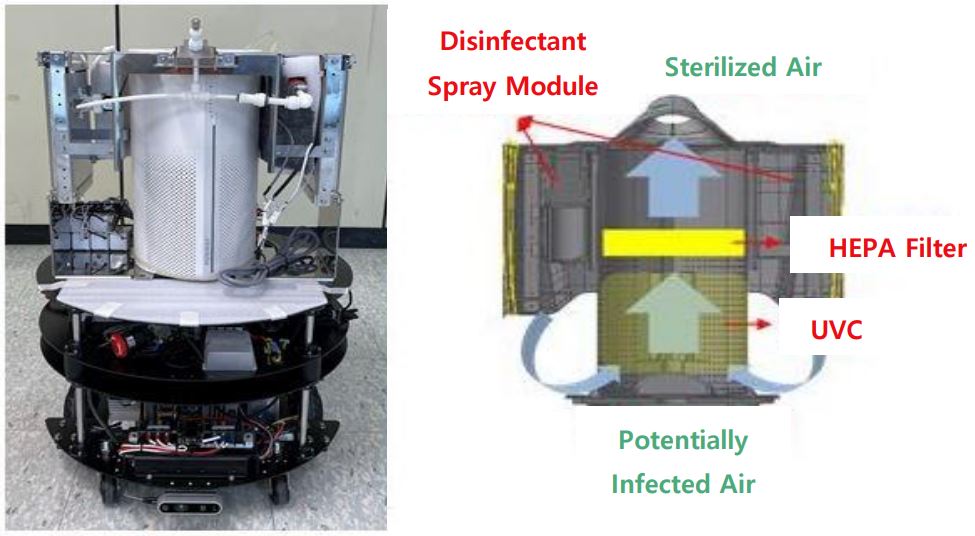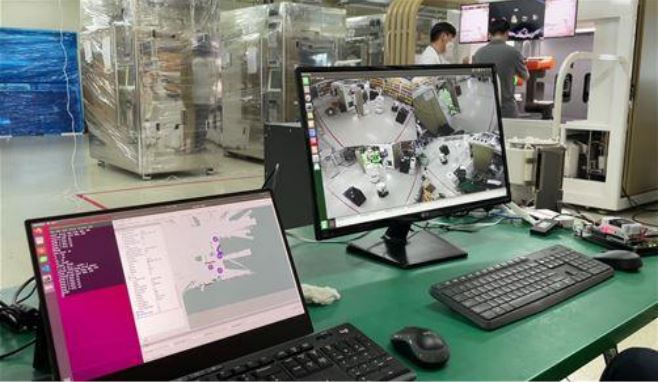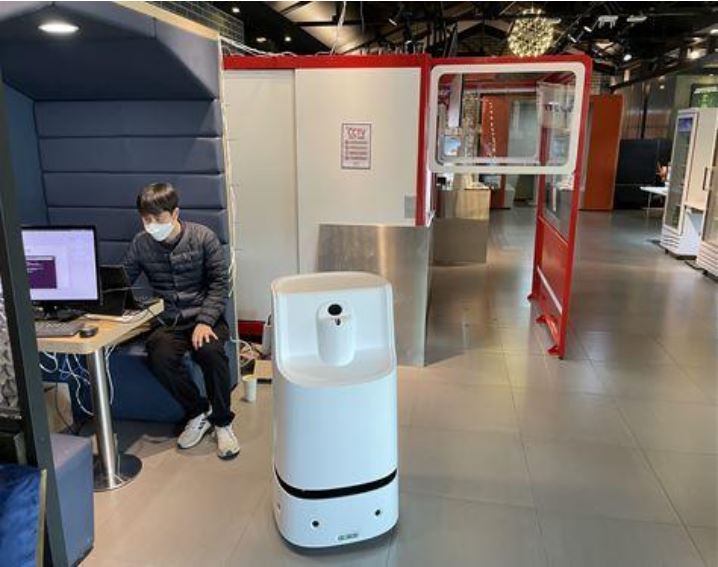
- Created2022.02.09
Development of AI-based Smart Robot for Infectious Disease Prevention
- A robot that finds and disinfects spaces as needed using a virus mapping algorithm -
- AI Autonomous Infectious Disease Prevention Robot Developed by the KIMM Department of AI Machinery -
An AI-based smart robot for infectious disease prevention has been developed to facilitate a safe means of automated infectious disease prevention even in crowded, indoor facilities. Unlike the existing autonomous infectious disease prevention robotics technology, which could only sterilize spaces without people, this new technology can implement infectious disease prevention measures safely for individuals in the same given space.
Principal Researcher Dr. Chang-Hyun Kim, Head of the Department of AI Machinery at the Korea Institute of Machinery and Materials (President Sang Jin Park, hereafter referred to as KIMM), developed an AI-based, smart infectious disease prevention robot equipped with a realtime virus spread estimation algorithm using AI. This technology can be easily applied to various commercial facilities where many people gather, such as cafes and restaurants, and is expected to help maintain daily life while lowering the risk of the spread of infectious diseases.
This newly developed robotics technology identifies people staying in a given indoor space using AI and analyzes the potential spread of viruses based on this data. Using this feature, the robot carries out a probability mapping algorithm for the distribution of viruses.
The algorithm for mapping virus probability calculates the optimal path for virus sterilization by estimating areas where viruses are most greatly concentrated based on various data, such as the location of people and how long they have stayed in a given area. Such data can be gathered by CCTV installed in indoor spaces. According to the calculation results, the infectious disease prevention robot can then conduct infectious disease prevention work along the most optimized path.
In addition, instead of directly using a UV-C sterilization lamp that can be harmful to the human body, the new robotics technology implements a method of spraying air that has undergone UVC sterilization, thus preventing the spread of infectious diseases while people are active in the same area. The smart infectious disease prevention robot can autonomously drive along an optimal movement path calculated according to the virus map, sterilizing seats and the air safely even if the seats are occupied.
Until now, robotics technology used for infectious disease prevention purposes faced various limitations, such as lowered efficiency due to the randomness of its operations, without close consideration for the distribution of viruses in a given space. Furthermore, due to the fact that such existing technologies involved directly using UV-C sterilization lamps to irradiate outside, they could not be effectively used to conduct infectious disease prevention measures in indoor areas occupied by many people, such as a restaurants or cafes.
Meanwhile, the newly developed AI-based intelligent infectious disease prevention robot is expected to greatly increase efficiency by accurately identifying the location of people in a given space and enabling rapid and accurate infectious disease prevention measures that target virusdense areas.
The KIMM research team conducted its research in cooperation with Vision Semicon, Co., Ltd., a manufacturing equipment company, to put the research results into practical use. Vision Semicon is known for its work in semiconductor manufacturing equipment and is now expanding its efforts to include unmanned robot cafes. This cooperative study was conducted in response to the COVID-19 pandemic and included work on the production of anti-droplet tables. Moving forward, the KIMM research team and Vision Semicon plan to operate the newly developed infectious disease prevention robots at unmanned cafes as a means of demonstrating the results of their research.
Dr. Chang-Hyun Kim of the Department of AI Machinery stated that the newly developed technology is an intelligent robot that uses AI to recognize the surrounding environment and can be used in spaces where many people gather. He explained that this technology can be used immediately in densely packed facilities, such as unmanned cafes and restaurants, to help business owners who are struggling during the pandemic.
[List of Attachments] - Attachment 1: AI-based Smart Infectious Disease Prevention Robot (Photo)
- Attachment 2: Human Recognition and Virus Mapping Algorithm Using Artificial Intelligence (Photo)
- Attachment 3: Self-driving Infectious Disease Prevention Robot Field Test (Photo)
The Korea Institute of Machinery and Materials (KIMM) is a non-profit governmentfunded research institute under the Ministry of Science and ICT. Since its foundation in 1976, KIMM is contributing to economic growth of the nation by performing R&D on key technologies in machinery and materials, conducting reliability test evaluation, and commercializing the developed products and technologies.
This research project was conducted with the support of the digital innovation technology development project for non-face-to-face business under the Ministry of Science and ICT, titled the “Development of an AI-based Autonomous Infectious Disease Prevention Robot and Anti-droplet System for Virus-free, Non-face-to-face, Unmanned Cafes”.
Credit : The Korea Institute of Machinery and Materials (KIMM)
Usage Restrictions of Multimedia (Attachment File) : The sources of photos and research results from KIMM must be specified.
- Attachment 1: AI-based Smart Infectious Disease Prevention Robot (Photo)

Description: Conceptual diagram of the robot system and the installed infectious disease prevention module to perform autonomous infectious disease prevention tasks.
- Attachment 2: Human Recognition and Virus Mapping Algorithm Using Artificial Intelligence (Photo)

Description: The KIMM Department of AI Machinery. Dr. Chang-Hyun Kim’s research team uses AI technology to recognize the shapes and locations of people appearing in CCTV footage (monitor on the right). This information is then used to develop a virus map (left) reflecting the optimal path for infectious disease prevention work.
- Attachment 3: Self-driving Infectious Disease Prevention Robot Field Test (Photo)

Description: A demonstration of the AI-based smart infectious disease prevention robot developed by Dr. Chang-Hyun Kim of the KIMM Department of AI Machinery, taking place at a smart, unmanned cafe in Daejeon, Korea.



